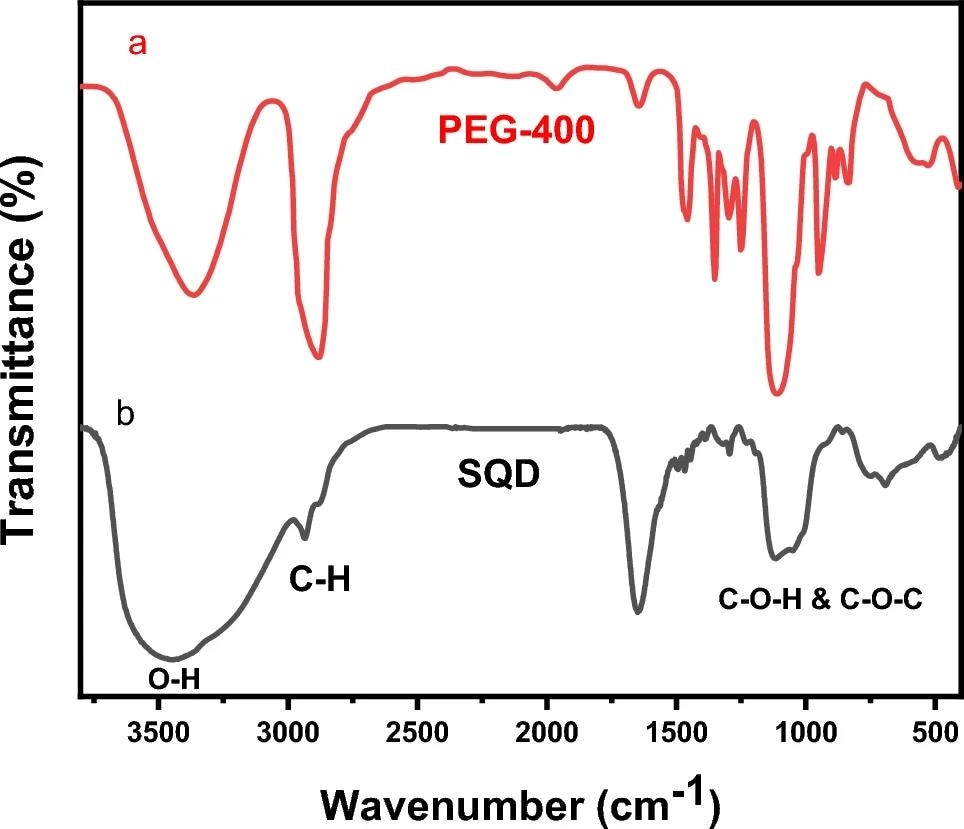In an article recently published in the journal Scientific Reports, researchers developed a Bacillus thuringiensis (Bt) formulation with improved ultraviolet (UV) radiation protection using sulfur quantum dots.
 FT-IR spectrum of (a) PEG-400 and (b) SQDs. Image Credit: https://www.nature.com/articles/s41598-024-68595-1
FT-IR spectrum of (a) PEG-400 and (b) SQDs. Image Credit: https://www.nature.com/articles/s41598-024-68595-1
Background
Bt, a bacteria-based microbial insecticide, is a pest control product that is extensively employed in forestry and agriculture. Bt's insecticidal crystal proteins are toxic to several insect species like nematodes, coleopterans, and Lepidoptera, but are considered safe for both humans and the environment.
However, Bt's persistence determines this product's effectiveness as a pest control agent. Bt's crystals and spores are vulnerable to degradation when exposed to UV radiation in sunlight, thereby resulting in a shortened persistence. This leads to a reduction in activity and limits its usefulness as a pesticide. Thus, identifying methods to increase the persistence and effectiveness of Bt formulations is necessary.
Importance of Sulfur Quantum Dots
Quantum dots can be used to address these limitations thanks to their distinct quantum confinement and optical properties. Sulfur quantum dots, a new zero-dimensional (0D) luminescent material class free of metal ions, display UV-visible absorption and bright photoluminescence.
Sulfur quantum dots are a class of green nanomaterial due to their excellent solubilities, low cost, high hydrophilicity, high biocompatibility, low toxicity, stable photoluminescence, and exceptional electronic and electrical properties. These quantum dots can be sustainably and easily synthesized using sublimated sulfur by-products, which are produced on a mass scale in petroleum refineries.
Additionally, the functional groups on the sulfur quantum dot surface provide electrons that enhance the interaction with other compounds. However, research on sulfur quantum dots is still in its early stages compared to the exploration of pure elemental quantum dots.
The Study
In this study, the researchers developed a novel Bt formulation with enhanced UV protection using sulfur quantum dots as stabilizing agents in a Pickering emulsion. The objective of this work was to develop a new formulation with longer persistence and higher activity using nanotechnology.
Polyethylene glycol-400 (PEG-400), ethanol (99.5 %), sodium chloride, ammonium persulfate, sodium dodecyl sulfate, methacrylic acid, methyl methacrylate, copper nitrate, sodium hydroxide, sublimated sulfur powder, thiourea, and Bt subsp. kurstaki KD-2 were allmused as starting materials.
50 mL of ultrapure deionized water, 4.0 g of sodium hydroxide, and 3.0 mL of PEG-400 were mixed and 1.4 g of sublimated sulfur powder were then added and stirred for a predetermined time of 100-125 hours at a constant temperature. Sulfur powder dissolved gradually and its color changed to dark red over time as the reaction progressed.
The obtained product was centrifuged at 6000 rpm to separate reactants from sulfur quantum dots. Researchers characterized the sulfur quantum dots using Fourier transform infrared (FTIR) spectroscopy, X-ray diffraction (XRD), transmission electron microscopy (TEM), high-resolution TEM (HRTEM), and fluorescence and UV analyses.
Additionally, they prepared poly (methyl methacrylate-co-methacrylic acid) [P (MMA-co-MA)], Pickering emulsions stabilized by sulfur quantum dots/microcapsule formulation, sulfur quantum dot formulation (non-microcapsules), and unprotected Bt formulation/free spore.
Free spores were used as a control, alongside a sulfur quantum dot formulation (non-microcapsules) and a diluted microencapsulated formulation with Bt subsp. kurstaki KD-2, during the exposure of emulsions to UV radiation. The samples were exposed to UV radiation for seven days using a 385 nm UVA tube mounted 140 mm above the open Petri dishes. Colony-forming units (CFUs) were counted to determine the spore count.
Study Contributions
The characterization of the obtained sulfur quantum dots confirmed the formation of spherical, well-dispersed quantum dots. These synthesized quantum dots demonstrated photoluminescent properties as a function of reaction time, high stability, and excellent dispersion.
A Pickering emulsion encapsulated by Bt and stabilized by sulfur quantum dots was successfully fabricated without any surfactant stabilizers. Encapsulation here refers to the process of enclosing Bt crystals and spores within a protective barrier formed using a Pickering emulsion stabilized by sulfur quantum dots.
Additionally, the microcapsule formulation with sulfur quantum dots displayed superior UV stability, maintaining 57.77 % spore viability after 96 hours of UV exposure. This was compared to 33.74 % and 31.25 % spore viability maintained by the sulfur quantum dot formulation (non-microcapsules) and unprotected Bt formulations/free spores, respectively.
Moreover, the microcapsule formulation exhibited higher insecticidal activity, resulting in 71.22 % larval mortality, which was significantly higher than the 42.34 % and 38.42 % larval mortality achieved with other formulations.
In summary, the findings of this study demonstrated the effectiveness of the microcapsule formulation with sulfur quantum dots in protecting Bt spores and crystals against UV radiation, thereby improving their practical application in pest control. The proposed approach represents a feasible strategy for developing more resilient biopesticides with a longer shelf life.
Journal Reference
Jalali, E., Maghsoudi, S. (2024). Enhancing UV radiation protection of Bacillus thuringiensis formulations using sulfur quantum dots: Synthesis and efficacy evaluation. Scientific Reports, 14(1), 1-12. DOI: 10.1038/s41598-024-68595-1, https://www.nature.com/articles/s41598-024-68595-1
Disclaimer: The views expressed here are those of the author expressed in their private capacity and do not necessarily represent the views of AZoM.com Limited T/A AZoNetwork the owner and operator of this website. This disclaimer forms part of the Terms and conditions of use of this website.
Article Revisions
- Aug 8 2024 - Title changed from "Quantum Dots Enhance UV Protection for Bt" to "Quantum Dots Enhance UV Protection for Bacillus Thuringiensis".